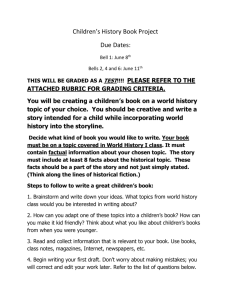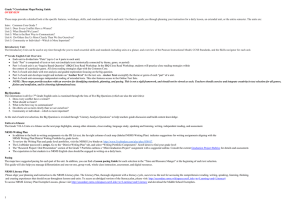1st Quarter
advertisement
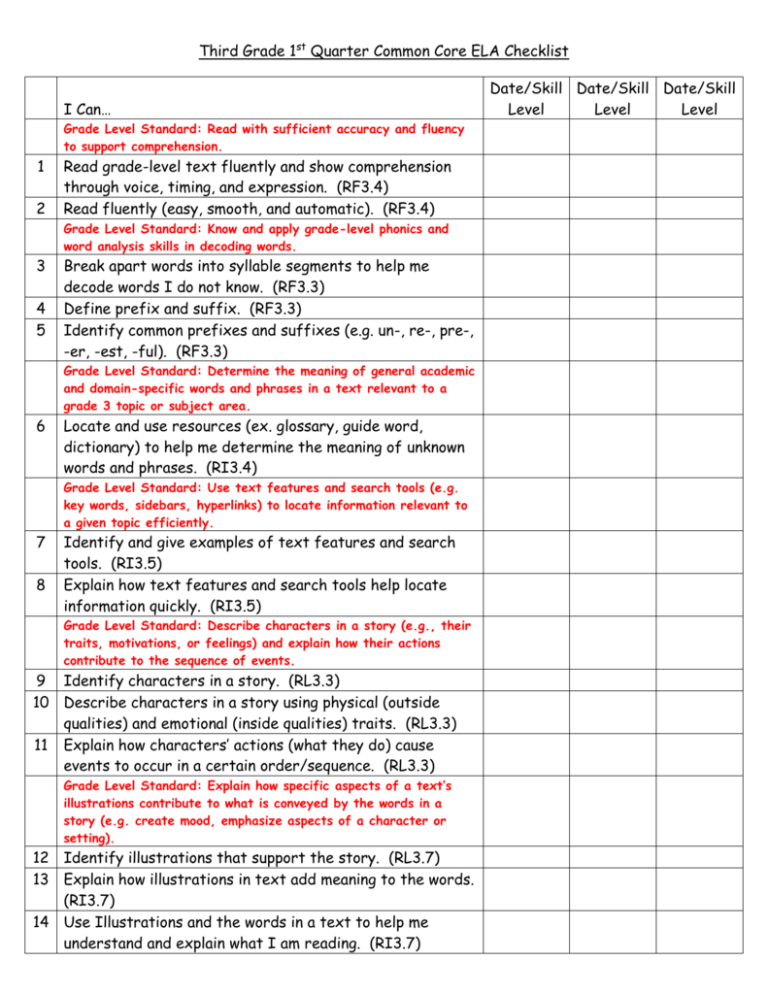
Third Grade 1st Quarter Common Core ELA Checklist I Can… Grade Level Standard: Read with sufficient accuracy and fluency to support comprehension. 1 2 Read grade-level text fluently and show comprehension through voice, timing, and expression. (RF3.4) Read fluently (easy, smooth, and automatic). (RF3.4) Grade Level Standard: Know and apply grade-level phonics and word analysis skills in decoding words. 3 4 5 Break apart words into syllable segments to help me decode words I do not know. (RF3.3) Define prefix and suffix. (RF3.3) Identify common prefixes and suffixes (e.g. un-, re-, pre-, -er, -est, -ful). (RF3.3) Grade Level Standard: Determine the meaning of general academic and domain-specific words and phrases in a text relevant to a grade 3 topic or subject area. 6 Locate and use resources (ex. glossary, guide word, dictionary) to help me determine the meaning of unknown words and phrases. (RI3.4) Grade Level Standard: Use text features and search tools (e.g. key words, sidebars, hyperlinks) to locate information relevant to a given topic efficiently. 7 8 Identify and give examples of text features and search tools. (RI3.5) Explain how text features and search tools help locate information quickly. (RI3.5) Grade Level Standard: Describe characters in a story (e.g., their traits, motivations, or feelings) and explain how their actions contribute to the sequence of events. 9 Identify characters in a story. (RL3.3) 10 Describe characters in a story using physical (outside qualities) and emotional (inside qualities) traits. (RL3.3) 11 Explain how characters’ actions (what they do) cause events to occur in a certain order/sequence. (RL3.3) Grade Level Standard: Explain how specific aspects of a text’s illustrations contribute to what is conveyed by the words in a story (e.g. create mood, emphasize aspects of a character or setting). 12 Identify illustrations that support the story. (RL3.7) 13 Explain how illustrations in text add meaning to the words. (RI3.7) 14 Use Illustrations and the words in a text to help me understand and explain what I am reading. (RI3.7) Date/Skill Date/Skill Date/Skill Level Level Level Grade Level Standard: Compare and contrast the themes, settings, and pots of stories written by the same author about the same or similar characters (e.g. in books from a series). 15 Define setting (the time and place of a story). (RL3.9) 16 Define plot (the sequence of events in a story). (RL3.9) Grade Level Standard: Determine the main idea of a text; recount the key details and explain how they support the main idea. 17 Define main idea (who or what is the text mostly about). (RI3.2) Grade Level Standard: Explain how specific aspects of a text’s illustrations contribute to what is conveyed by the words in a story (e.g., create mood, emphasize aspects of a character or setting). 18 Explain how illustrations contribute (add meaning) to the words, mood, setting, and the characters in the story. (RL3.7) Grade Level Standard: Distinguish their own point of view from that of the narrator or those of the characters. 19 Define point of view (someone’s view or attitude about a situation). (RL3.6) Grade Level Standard: Describe the relationship between a series of historical events, scientific ideas or concepts, or steps in technical procedures in a text, using language that pertains to time, sequence, and cause/effect. 20 Use language that shows time (before, now, later, etc.) and sequence (first, next, last, etc.) when describing a text. (RI3.3) Grade Level Standard: Recount stories, including fables, folktales and myths from diverse cultures; determine the central message, lesson, or moral and explain how it is conveyed through the key details in the text. 21 Recount/retell (put in my own words) stories. (RL3.2) Grade Level Standard: Ask and answer questions to determine understanding of a text referring explicitly to the text as the basis for the answers. 22 Locate words and details to answer explicit questions in a text. (RL3.1) 23 Ask and answer questions before, during and after reading a text. (RL3.1) Grade Level Standard: Ask and answer questions to demonstrate understanding of a text, referring explicitly to the text as the basis for the answers. 24 Locate words and details to answer explicit questions in a text. (RI3.1) Grade Level Standard: Determine the meaning of words and phrases as they are used in a text, distinguishing literal from nonliteral language. 25 Use context clues to determine the meaning of literal and non-literal language. (RL3.4) 26 Define literal language (it says what it means) and nonliteral (what it says is not exactly what it means). (RL3.4) MT= More Time Needed Notes: P= Proficient A= Advanced


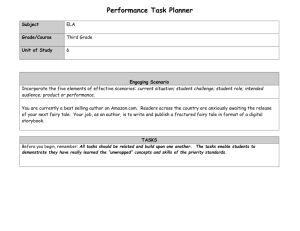
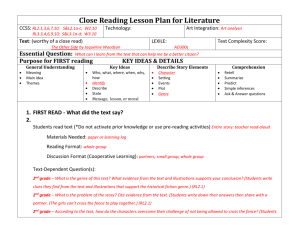
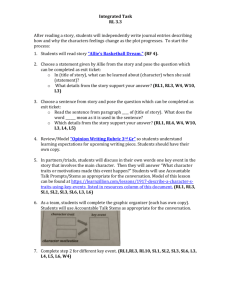

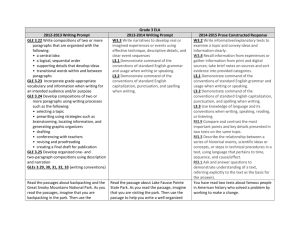
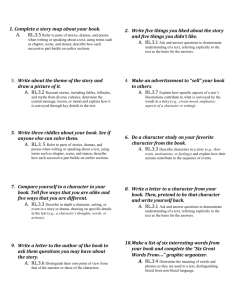
![Creating Worksheets [MS Word, 78 Kb]](http://s3.studylib.net/store/data/006854413_2-7cb1f7a18e46d36d8c2e51b41f5a82fa-300x300.png)
